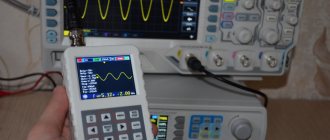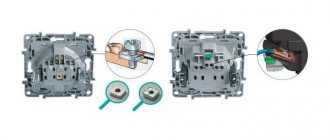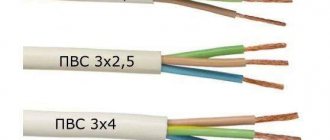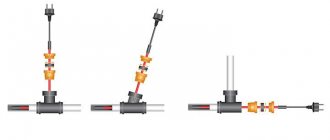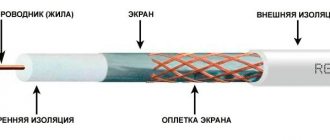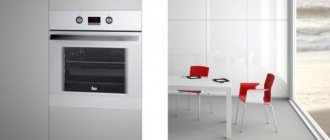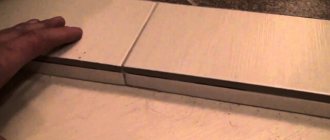How are the connectors different?
There are different socket standards used around the world. In the technical parameters of the device there may be symbols that help you understand what type of power plug is used - EU, US, AU, UK. You can also find the abbreviations UK plug, EU plug - it’s not difficult to figure out what this means. Here are the varieties depending on the country for which the device is intended:
- UK - a plug used in Britain (United Kingdom), it has three flat pins. Such connectors can be found in England, Ireland, Scotland and some other countries.
- EU is the most common plug; in addition to Russia, it is used in Belarus and other countries of the post-Soviet space. The EU plug for the socket is also in use in most European countries. Euro plug comes in two types - C and F, the latter has additional contacts for grounding.
- AU socket - this type of connector is made in China and a number of other Asian countries, as well as in Australia. It differs from a Euro plug in that it has two flat contacts located at an angle to each other.
- The US plug is used in the USA, South America and Japan. It comes in two types - A and B. The first has two vertical flat pins parallel to each other, the second has an additional hole for grounding.
In total, there are 12 different types of connectors in the world, but these 4 are the most common. Their types are used in Italy, Switzerland, Israel, Thailand and African countries. Of all the varieties, only one is used in our country.
Funny pictures, videos, jokes and news
If you order various electrical appliances and devices through foreign online stores like Aliexpress or Ebay, then in the order parameters you will often find a selection option - US plug, UK plug, EU plug or AU plug. What is this and what does this designation mean?!
You probably know that there are different types of electrical outlets used around the world. So, to indicate the type of connector used by the device for connecting to the electrical network, special symbols are used. What is their difference? Here are the four main types of plugs:
1. UK Plug - English or British socket, type G (three flat pins). Used in the UK, Singapore, Malta and Cyprus. Operating voltage 220-240 Volts.
2. AU Plug - Australian socket, type I. Used in Australia, New Guinea, New Zealand, Fiji, Samoa, China. Operating voltage 220-240 Volts.
3. EU Plug - the so-called “Euro” connector of the socket, type C and F (additionally 2 grounding contacts). A regular European socket used in Russia, CIS countries, the European Union, as well as in many other countries (Turkey, Egypt, Algeria, Tunisia, etc.). The voltage used is 220-240 Volts at a frequency of 50 Hz.
4. US Plug - American socket, Type A (two vertical flat pins) and B (with a third hole for grounding). Used in the USA, as well as in the countries of South America and Japan. The voltage used is 100-127 Volts at a frequency of 60 Hz.
In addition, there are a number of less common types of electrical outlet plugs:
There are a total of 12 types of sockets in the world. Among them are Italian, Thai, African, Swiss, Israeli, etc. They are used much less frequently, but nevertheless they also have a place.
From the largest travel company in the Baltics
What type of plug is used in Russia?
On the territory of the Russian Federation, EU plug is used, translated into Russian this is what EC standard plugs are called. As noted above, both the plugs themselves and the sockets for them may differ.
The most popular is type C. The second most common is F, in which the size, shape and arrangement of contacts is the same as the first type, but there are additional clamping plates on both sides for grounding.
Attention!
Type F is characterized by a deeper socket. An EU plug for a C-socket cannot be connected to it. Although the reverse use is quite possible.
What to do if you bought the wrong type of plug on Aliexpress?
When choosing electrical goods on foreign trading platforms, you need to carefully look at whether the lot in question has the type of plug that is used in Russia. You need to be especially careful if the parameters indicate a US connector - in the USA, the network uses a voltage of 110 V, and such plugs will not fit into the Russian electrical network.
If the specifications do not indicate the type of connector, a photo will help make sure that the device has a European standard plug - you can ask the seller to make one and send it. But sometimes, especially with cheap electrical devices, there is no choice of plug type. There is no need to be afraid of this - if you are satisfied with all other parameters of the product, there is a way out.
World standards of all countries for sockets, plugs, voltage and current frequency
When preparing to travel abroad, we take with us many electronic gadgets, such as electric razors, phones, tablets, laptops, e-readers, cameras, MP3 players, etc. But not everyone knows that every country has a different electrical system, with different standards of electrical plugs and sockets, different frequencies, voltages and currents.
Read also: Replacing an LED in a lamp with your own hands
Therefore, before traveling abroad, it is a good idea to find out in advance about the electrical system in the country you will be visiting. Otherwise, it may turn out that in your host country you will not be able to charge your electronic device or even turn it on for mains operation.
Most power supplies for electronic devices such as laptops, chargers, mobile devices, camcorders and cameras have a universal power supply, so they are capable of operating at a supply voltage of 100 to 240 Volts, and a frequency of 50 or 60 Hz.
Map diagram of the use of voltage and current frequency in different countries of the world
As you can see, most electronic devices and gadgets are adapted to work in a wide range of electrical systems in different countries, but there is a very important point related to the variety of electrical plugs and sockets in these electrical systems. In different countries, the standards for sockets and plugs are different, so you simply cannot connect the charger to this outlet, since it simply will not fit there.
To protect ourselves from such disappointments, we should take care of this in advance by purchasing the appropriate adapter or adapter for charging this device. Today you can buy a universal set of adapters that are suitable for most countries of the world.
Map diagram of the use of electrical plugs and sockets by type in different countries of the world
But still, before traveling to another country, it would be a good idea to find out about the standard of the electrical system in it, find out the standard for plugs and sockets.
Below you will see a table that describes the standards of electrical systems in all countries of the world. Moreover, grouped by continents, clicking on the link with the name of the continent will immediately redirect you to the desired area of text with a description of the countries of this continent.
Note! There are countries that have different electrical system standards depending on the region or area, such as Brazil or the Maldives. In this case, you should check more precisely which standard applies in this particular area of the country. If a country has multiple standards, this will be indicated in the table provided, otherwise there will be one entry per country.
So, first, let's look at all the standards of electrical plugs and sockets available in the world with the accompanying photograph and more detailed description. Here you can find out what, for example, an American, European, Japanese, Australian, etc. socket looks like.
Read also: Welding fixtures and mechanisms
Chinese plugs in the Russian power grid
In the Middle Kingdom, two types of sockets are used. They are in no way compatible with European ones. Their contacts are located at a greater distance and have a different connector shape. The AU plug has two flat pins located at an angle to each other. For more powerful devices, another type is used - with additional grounding.
Even if you purchase an adapter, it may not be very convenient - the adapter increases the size of the connection point and may interfere with the installation of furniture. The problem can be solved by independently converting the Chinese plug into the familiar F type.
Types of electrical sockets and plugs from around the world
Type A is an American electrical socket and plug. It has two flat parallel contacts. Used in most countries in North and Central America, particularly the United States, Canada, Mexico, Venezuela and Guatemala, as well as Japan. And also wherever the voltage is 110 V.
Type B is the same connector as Type A, but with an additional round ground pin. Typically used in the same countries as the Type A connector. Type C is a European socket and plug. It has two round contacts parallel to each other. It does not have a third ground pin. It is the most popular outlet in Europe, excluding the United Kingdom, Ireland, Malta and Cyprus. Used where the voltage is 220 V.
Type D is the old British standard with three round pins arranged in a triangle shape with one pin being thicker than the other two. This socket standard is used for maximum current and is used in India, Nepal, Namibia and Sri Lanka.
Type E is a plug with two round pins and a hole for the ground pin, which is located in the socket of the socket. This type of socket is currently used in Poland, France and Belgium.
Type F - This standard is similar to Type E, but instead of a round ground pin, it uses two metal clamps on either side of the connector. This type of socket is used, for example, in Germany, Austria, Holland, Norway and Sweden.
Type G is a British socket with three flat contacts. Currently used in the UK, Ireland, Malta, Cyprus, Malaysia, Singapore and Hong Kong. Note – this type of outlet often comes with a built-in internal fuse. Therefore, if after connecting the device it does not work, then the first thing to do is check the condition of the fuse in the socket, perhaps this is the problem.
Type H - This socket connector is used only in Israel and the Gaza Strip. Has three flat pins, or the earlier version has round pins arranged in a B shape. Not compatible with any other plug. It is intended for voltage values of 220 V and current up to 16 A.
Type I is an Australian socket, it has two flat contacts, like the American Type A connector, but they are located at an angle to each other - in the shape of the letter B. There is also a version with a ground contact. This type of socket is used in Australia, New Zealand, Papua New Guinea and Argentina.
Read also: How to properly sharpen a metal drill video
Type J is a Swiss plug and socket. It is similar to the Type C plug, but has an additional grounding pin in the middle and two round power pins. Used in Switzerland and beyond in Liechtenstein, Ethiopia, Rwanda and the Maldives.
Type K is a Danish socket and plug and is similar to the popular European Type C socket, but additionally has a ground pin located at the bottom of the connector. It is the basic standard mainly in Denmark and Greenland, but also in Bangladesh, Senegal and the Maldives.
Type L is an Italian plug and socket, it is similar to the popular European Type C socket, but has an additional round ground pin located in the center, the two round power pins are arranged unusually in a line. This socket is used in Italy, as well as Chile, Ethiopia, Tunisia and Cuba.
Type M is an African socket and plug with three round pins arranged in a triangle shape, with the ground pin being clearly thicker than the other two. It is similar to the D-type connector, but has much thicker pins. The socket is designed to power devices with a current of up to 15 A. Used in South Africa, Swaziland and Lesotho.
